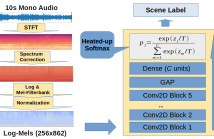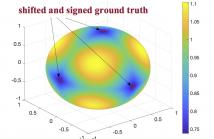
ICASSP is the world’s largest and most comprehensive technical conference focused on signal processing and its applications. The ICASSP 2020 conference will feature world-class presentations by internationally renowned speakers, cutting-edge session topics and provide a fantastic opportunity to network with like-minded professionals from around the world. Visit website.

- Read more about An Attention-Based Joint Acoustic and Text On-Device End-to-End Model'
- Log in to post comments
- Categories:
 85 Views
85 Views
- Read more about Stability of Graph Neural Networks to Relative Perturbations
- Log in to post comments
Graph neural networks (GNNs), consisting of a cascade of layers applying a graph convolution followed by a pointwise nonlinearity, have become a powerful architecture to process signals supported on graphs. Graph convolutions (and thus, GNNs), rely heavily on knowledge of the graph for operation. However, in many practical cases the graph shift operator (GSO) is not known and needs to be estimated, or might change from training time to testing time.
- Categories:
 21 Views
21 Views
- Read more about Acoustic Scene Classification for Mismatched Recording Devices Using Heated-Up Softmax and Spectrum Correction
- Log in to post comments
Deep neural networks (DNNs) are successful in applications with matching inference and training distributions. In realworld scenarios, DNNs have to cope with truly new data samples during inference, potentially coming from a shifted data distribution. This usually causes a drop in performance. Acoustic scene classification (ASC) with different recording devices is one of this situation. Furthermore, an imbalance in quality and amount of data recorded by different devices causes severe challenges. In this paper, we introduce two calibration methods to tackle these challenges.
- Categories:
 20 Views
20 Views- Read more about COMPLEX PAIRWISE ACTIVITY ANALYSIS VIA INSTANCE LEVEL EVOLUTION REASONING
- Log in to post comments
Video activity analysis systems are often trained on large datasets. Activities and events in the real-world do not occur in isolation, instead, they occur as interactions between related objects. This work introduces a novel method that jointly exploits relational information between pairs of objects and temporal dynamics of each object. The proposed method effectively leverages a new simple architecture that is flexible and easily trained to detect relational activities and events using small datasets (hundreds of samples).
- Categories:
 26 Views
26 Views
- Read more about Secure Identification for Gaussian Channels
- Log in to post comments
New applications in modern communications are demanding robust and ultra-reliable low latency information exchange such as machine-to-machine and human-to-machine communications. For many of these applications, the identification approach of Ahlswede and Dueck is much more efficient than the classical transmission scheme proposed by Shannon. Previous studies concentrate mainly on identification over discrete channels. We focus on Gaussian channels for their known practical relevance. We deal with secure identification over Gaussian channels.
- Categories:
 19 Views
19 Views
- Read more about ICASSP 2020 presentation slide of 'EXTRAPOLATED ALTERNATING ALGORITHMS FOR APPROXIMATE CANONICAL POLYADIC DECOMPOSITION'
- Log in to post comments
Tensor decompositions have become a central tool in machine learning to extract interpretable patterns from multiway arrays of data. However, computing the approximate Canonical Polyadic Decomposition (aCPD), one of the most important tensor decomposition model, remains a challenge. In this work, we propose several algorithms based on extrapolation that improve over existing alternating methods for aCPD.
- Categories:
 193 Views
193 Views
- Read more about Secure Identification for Gaussian Channels
- Log in to post comments
New applications in modern communications are demanding robust and ultra-reliable low latency information exchange such as machine-to-machine and human-to-machine communications. For many of these applications, the identification approach of Ahlswede and Dueck is much more efficient than the classical transmission scheme proposed by Shannon. Previous studies concentrate mainly on identification over discrete channels. We focus on Gaussian channels for their known practical relevance. We deal with secure identification over Gaussian channels.
- Categories:
 58 Views
58 Views
- Read more about MANIFOLD GRADIENT DESCENT SOLVES MULTI-CHANNEL SPARSE BLIND DECONVOLUTION PROVABLY AND EFFICIENTLY
- Log in to post comments
Multi-channel sparse blind deconvolution refers to the problem of learning an unknown filter by observing its circulant convolutions with multiple input signals that are sparse. It is challenging to learn the filter efficiently due to the bilinear structure of the observations with respect to the unknown filter and inputs, leading to global ambiguities of identification. We propose a novel approach based on nonconvex optimization over the sphere manifold by minimizing a smooth surrogate of the sparsity-promoting loss function.
- Categories:
 18 Views
18 Views
- Read more about TEMPORAL CODING IN SPIKING NEURAL NETWORKS WITH ALPHA SYNAPTIC FUNCTION
- Log in to post comments
We propose a spiking neural network model that encodes information in the relative timing of individual neuron spikes and performs classification using the first output neuron to spike. This temporal coding scheme allows the supervised training of the network with backpropagation, using locally exact derivatives of the postsynaptic with respect to presynaptic spike times. The network uses a biologically-inspired alpha synaptic transfer function and trainable synchronisation pulses as temporal references. We successfully train the network on the MNIST dataset encoded in time.
- Categories:
 25 Views
25 Views
- Read more about TEMPORAL CODING IN SPIKING NEURAL NETWORKS WITH ALPHA SYNAPTIC FUNCTION
- Log in to post comments
- Categories:
 12 Views
12 Views